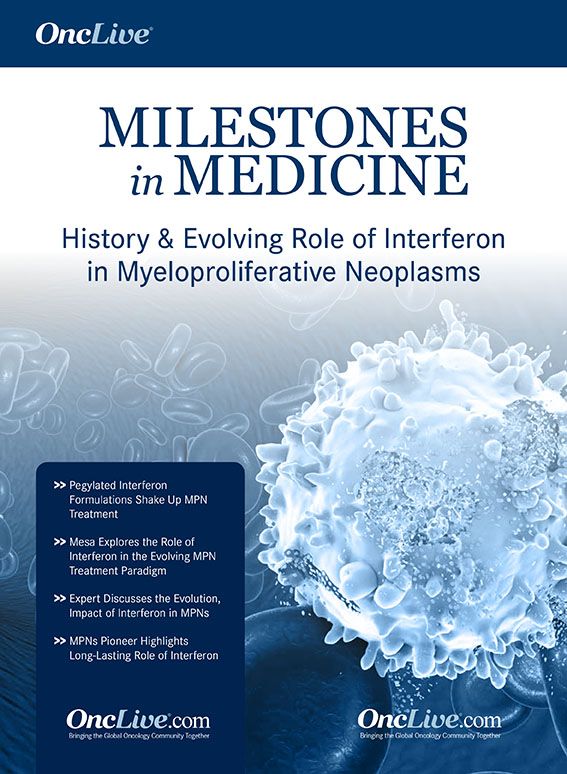Publication
Article
Supplements and Featured Publications
Pegylated Interferon Formulations Shake Up MPN Treatment
Author(s):
Abdulraheem Yacoub, MD, discusses the development of interferon and its current role in the management of patients with myeloproliferative neoplasms.
Abdulraheem Yacoub, MD

Abdulraheem Yacoub, MD
Due to the lack of comparative data between interferon and standard therapies, interferon has historically been reserved as a second-line therapy for patients with myeloproliferative neoplasms (MPNs). However, pegylated formulations, such as peginterferon alfa-2a (Pegasys) and ropeginterferon alfa-2b (PEG-Intron), have demonstrated higher safety, efficacy, and tolerability profiles, explained Abdulraheem Yacoub, MD.
In the phase III MPN-RC 112 trial, findings of which were presented at the 2018 ASH Annual Meeting, patients with polycythemia vera (PV) or high-risk essential thrombocythemia (ET) were randomized to receive either pegylated interferon alfa-2a or standard hydroxyurea. Results from the final analysis revealed that, at 12 months and 24 months, complete response rates between the arms were comparable. Further, neither medication resulted in a compromised quality of life (QoL).
“Now, there is a trend to advocate for interferon use as first-line therapy in addition to patients who have already tried other therapeutic options,” said Yacoub. “For patients who have had issues with tolerance or resistance to standard drugs, interferon remains a very viable second-line option.”
OncLive: How long has interferon been part of the MPN treatment paradigm?
In an interview with OncLive, Yacoub, associate professor of medicine at the University of Kansas Medical Center, discussed the development of interferon and its current role in the management of patients with MPNs.Yacoub: MPNs are rare blood cancers that were described many decades ago. Many therapeutic interventions have been planned and evaluated over the years. Interferon is one of the earlier therapies that we've had for this indication. Over the past 50 years, we have been using interferon with variable success. There has been a lot of progress since [it was first introduced to the landscape].
Could you elaborate on the different generations of the drug?
Initially, the biological version of the molecule was very similar to the natural interferon molecule; that resulted in significant anticancer activity but also significant adverse events (AEs). Over the years, we were able to fine-tune the treatment. We were also able to develop new molecules that continue to have the same activity with a much better side effect profile. Pegylated interferon is a lot more convenient, safer, and is better tolerated.The older versions of interferon were short-acting and required dosing on a daily basis or every other day; that resulted in significant AEs due to the fluctuation in interferon levels in the body. [Interferon] often had to be discontinued because of AEs, so patients were not able to stay on them for a long time. The more recent products that have been available for the last 20 years have been chemically modified to allow [the treatment] to function for a longer duration of time. Patients who had significant AEs [with older generations] were able to stay on the interferon for a longer period of time and had better long-term tolerance and results [with the recent products].
There are no FDA-approved products, so a lot of what we use is off-label. [Genentech’s]
What is the current role of interferon in the treatment of patients with MPNs?
peginterferon alfa-2a is the most commonly used version; it’s administered weekly with titration options in the dose and the schedule. Peginterferon alfa-2a is the agent we have the most experience with. There is also a newer, longer-acting version called ropeginterferon alfa-2b that is not yet commercially available in the United States. Most of the experience in the United States and Europe has been with peginterferon alfa-2a. Most of the published literature used that drug, although a lot of the upcoming studies are evaluating the use of the longer-acting ropeginterferon alfa-2b. Interferon provides a very unique therapeutic strategy for these patients. It's one of the safest drugs we can give them. It's a drug we use for younger patients, pregnant women, and those who want [children in the future]. We can also use it long-term without concerns of secondary toxicity, whereas the long-term use of other medications and chemotherapeutic agents are known to induce toxicities, including the possibility of a second cancer. The safety allows us to advocate for early interferon use in certain patient populations.
What are the data that support its use as frontline therapy?
In terms of activity or efficacy, we really never knew whether interferon was the superior treatment compared with other standard treatments. Recently, a few randomized clinical trials have shown that interferon is as effective as, and potentially even superior to, older therapeutic options including antimetabolites and cytotoxic agents.One of the best highlights of the 2018 ASH Annual Meeting in MPNs was the phase III MPN-RC 112 trial. This randomized global study was conducted in multiple countries and 3 continents. Over 160 patients were randomized between the standard treatment, hydroxyurea, versus pegylated interferon alfa-2a. Hydroxyurea was compared with interferon in terms of efficacy, safety, and QoL, as well as the rate of complications, clotting, and bleeding events. The study was definitively practice-changing.
How do you decide between interferon and hydroxyurea?
Everybody expected this study to have a clear winner, but both arms achieved results and responses above the predefined endpoint. Everybody reached the conclusion that both options are a reasonable first-line therapy for all patients. People always thought that interferon had so many associated AEs, that even though it might work as well as or better than hydroxyurea, the events might make the QoL worse. That was not the case on the study. QoL was tested prospectively. Patients did not have a worse QoL or more AEs while they were treated on interferon compared with hydroxyurea. That was another debunked myth with interferon.There are advantages with both options. Hydroxyurea is readily available and very inexpensive. All doctors are very comfortable prescribing it and managing it. It’s an active drug—70% of patients who receive hydroxyurea will not need any additional therapy. Interferon is also a very good first- or second-line treatment option for patients, but there are some challenges associated with it. Two challenges are the availability and the cost. Since the medication is not FDA-approved for this indication, acquiring it through insurance takes multiple attempts and may not always be approved. However, we have made a lot of progress recently; a lot of insurance providers are now approving interferon for patients.
Where is future research with interferon headed?
Interferon does have its own unique contraindications and risks for which patients should be carefully selected. There is no particular age or demographic that benefits more from interferon; it’s a fair option for all patients of all ages. However, it's not a reasonable option for patients without controlled autoimmune disorders. Interferon works as an immune modulator and can result in increased severity of autoimmune disorders. It’s also not a good drug for patients with uncontrolled mood and depression disorders because it may induce or worsen depression. Patients should be selected carefully and screened for uncontrolled psychiatric or mood disorders prior to starting interferon. We're always trying to achieve disease control in our patients with the least amount of side effects. [We hope clinical trials will guide us] in our choice of therapy. The most recent molecule, ropeginterferon alfa-2b is a candidate for future clinical trials. It has a significant half- life that allows for administration every 14 days or every month—that’s a significant improvement in QoL and convenience for patients. This particular medication was studied in international clinical trials and was also found to be noninferior to hydroxyurea, and potentially superior as long-term therapy. This molecule is being investigated in an international clinical trial for first- or second-line therapy for patients with ET and PV.
What are the remaining challenges with interferon?
There has also been data with the use of interferon for patients with newly diagnosed myelofibrosis who don’t have advanced disease features or advanced scarring of the bone marrow. These data show that interferon might result in a slowing or modifying of the disease behavior. In addition, interferon combinations are now emerging to try to boost its activity and result in a deeper, faster, or safer response. There is a learning curve for physicians and patients starting interferon. In the hands of practiced physicians, interferon can be managed very safely. Many clinical trials have shown that more than 85% of patients can manage their AEs without having to discontinue therapy. We encourage patients to seek an expert opinion prior to making a decision for or against it.
Mascarenhas J, Kosiorek HE, Prchal J, et al. Results of the Myeloproliferative Neoplasms - Research Consortium (MPN-RC) 112 randomized trial of pegylated interferon alfa-2a (peg) versus hydroxyurea (hu) therapy for the treatment of high risk polycythemia vera (PV) and high risk essential thrombocythemia (ET). Presented at: 2018 ASH Annual Meeting; December 1-4, 2018; San Diego, CA. Abstract 577.
























%20(2)%201-Recovered-Recovered-Recovered-Recovered-Recovered-Recovered-Recovered-Recovered-Recovered-Recovered-Recovered-Recovered-Recovered-Recovered-Recovered-Recovered-Recovered.jpg?fit=crop&auto=format)
%20(2)%201-Recovered-Recovered-Recovered-Recovered-Recovered-Recovered-Recovered-Recovered-Recovered-Recovered-Recovered-Recovered-Recovered-Recovered-Recovered-Recovered-Recovered.jpg?fit=crop&auto=format)